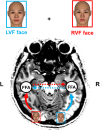Measurement of ultra-fast signal progression related to face processing by 7T fMRI
- PMID: 31925902
- PMCID: PMC7268038
- DOI: 10.1002/hbm.24907
Measurement of ultra-fast signal progression related to face processing by 7T fMRI
Abstract
Given that the brain is a dynamic system, the temporal characteristics of brain function are important. Previous functional magnetic resonance imaging (fMRI) studies have attempted to overcome the limitations of temporal resolution to investigate dynamic states of brain activity. However, finding an fMRI method with sufficient temporal resolution to keep up with the progress of neuronal signals in the brain is challenging. This study aimed to detect between-hemisphere signal progression, occurring on a timescale of tens of milliseconds, in the ventral brain regions involved in face processing. To this end, we devised an inter-stimulus interval (ISI) stimulation scheme and used a 7T MRI system to obtain fMRI signals with a high signal-to-noise ratio. We conducted two experiments: one to measure signal suppression depending on the ISI and another to measure the relationship between the amount of suppression and the ISI. These two experiments enabled us to measure the signal transfer time from a brain region in the ventral visual stream to its counterpart in the opposite hemisphere through the corpus callosum. These findings demonstrate the feasibility of using fMRI to measure ultra-fast signals (tens of milliseconds) and could facilitate the elucidation of further aspects of dynamic brain function.
Keywords: fMRI; inter-stimulus interval; interhemispheric transfer time.
© 2020 The Authors. Human Brain Mapping published by Wiley Periodicals, Inc.
Figures









References
-
- Baldauf, D. , & Desimone, R. (2014). Neural mechanisms of object‐based attention. Science, 344, 424–427. http://science.sciencemag.org/content/344/6182/424 - PubMed
-
- Barca, L. , Cornelissen, P. , Simpson, M. , Urooj, U. , Woods, W. , & Ellis, A. W. (2011). The neural basis of the right visual field advantage in reading: An MEG analysis using virtual electrodes. Brain Lang, 118, 53–71. http://www.sciencedirect.com/science/article/pii/S0093934X10001495 - PubMed
-
- Barnett, K. J. , & Corballis, M. C. (2005). Speeded right‐to‐left information transfer: The result of speeded transmission in right‐hemisphere axons? Neuroscience Letters, 380, 88–92. http://www.sciencedirect.com/science/article/pii/S0304394005000637 - PubMed
-
- Brown, W. S. , Larson, E. B. , & Jeeves, M. A. (1994). Directional asymmetries in interhemispheric transmission time: Evidence from visual evoked potentials. Neuropsychologia, 32, 439–448. http://www.sciencedirect.com/science/article/pii/0028393294900892 - PubMed
Publication types
MeSH terms
LinkOut - more resources
Full Text Sources
Medical

